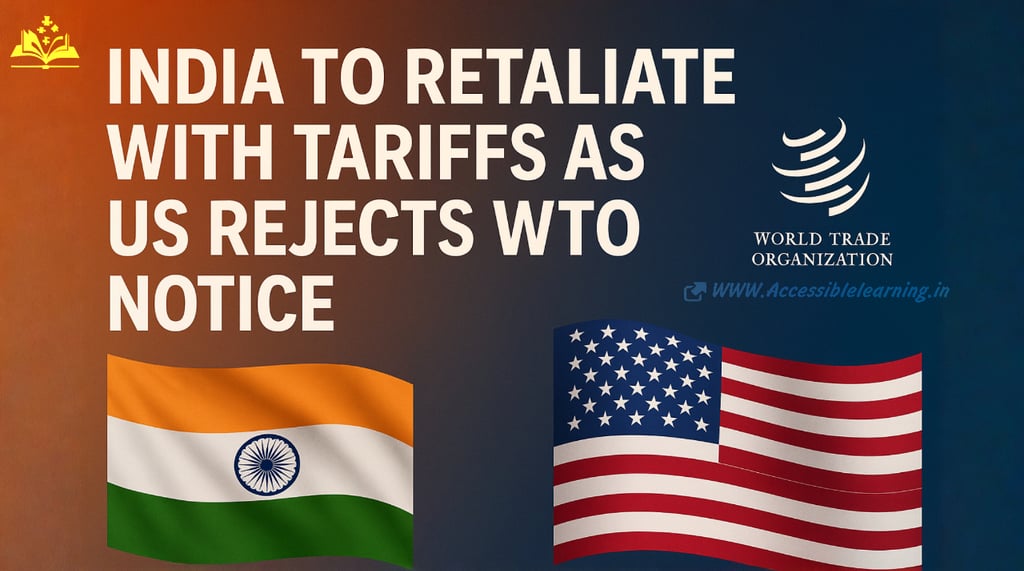
India to Retaliate with Tariffs as US Rejects WTO Notice: What It Means for Global Trade
India is set to impose retaliatory tariffs on US goods after Washington rejected a WTO ruling against its steel and aluminum duties. This escalation could reshape global trade dynamics and test the strength of India–US relations.
NEWS/CURRENT AFFAIRSUSAPOLITICAL JOURNEYINDIA/BHARATNEPOTISM/SOCIAL ISSUES
Keshav Jha
6/5/20253 min read


In a dramatic escalation of trade tensions, India has announced plans to impose retaliatory tariffs on the United States after Washington rejected a World Trade Organization (WTO) panel notice that found US duties to be inconsistent with global trade rules. This move signifies a strategic pivot in India's trade policy and could reverberate through global economic corridors, particularly as geopolitical alliances continue to shift.
Background: What Sparked the Conflict?
The friction between India and the United States traces back to the Trump-era tariffs imposed under Section 232 of the US Trade Expansion Act of 1962. The US had levied additional duties on steel (25%) and aluminum (10%) imports from various countries, including India, citing national security concerns.
India filed a complaint at the WTO in 2019, arguing that these tariffs violated global trade norms. After years of deliberation, a WTO dispute panel ruled in India's favor in late 2023, stating the US actions were unjustified and did not meet the criteria for national security exceptions.
However, the US, under the Biden administration, has flatly rejected the WTO's ruling, insisting that its tariffs are lawful and that the WTO does not have the authority to review national security decisions. This unilateral stance has now triggered India to consider retaliatory action.
India’s Response: Tariff Retaliation on the Horizon
India has formally notified the WTO that it will impose retaliatory tariffs worth approximately $235 million on select US imports. Though the list of targeted products has not yet been made public, sources suggest they could include:
Agricultural products like almonds, walnuts, and apples (key US exports to India)
Industrial goods, including certain types of machinery and chemicals
Consumer goods to exert political pressure during a US election year
India's decision aligns with WTO dispute rules, which allow members to suspend concessions when another member refuses to comply with dispute rulings. By initiating tariff measures, India is asserting its right to defend its trade interests in a rule-based order.
Why the WTO Notice Matters
The WTO operates on a consensus-based mechanism, where member states are expected to abide by dispute rulings to ensure a fair, rules-based global trading system. The US’s rejection of the WTO panel’s findings sends a troubling signal to other member nations. It sets a precedent that powerful economies can sidestep multilateral obligations without facing immediate consequences.
India's retaliation is not just about defending its own interests—it is also a call to uphold the credibility and effectiveness of the WTO.
Broader Implications for Global Trade
Strain on India–US Trade Relations
The tariff conflict could strain the growing economic relationship between India and the United States. While the two nations have strengthened ties in technology, defense, and strategic areas, trade has often been a point of contention.
India is currently the ninth-largest trading partner of the US, and any tariffs could disrupt supply chains, raise costs, and complicate trade negotiations—particularly the ongoing discussions around a bilateral trade agreement.
Ripple Effects on the WTO System
The US refusal to comply with WTO rulings adds fuel to the argument that the WTO is becoming increasingly ineffective in dealing with disputes involving major economies. With the US having already blocked appointments to the WTO Appellate Body, the multilateral dispute settlement mechanism is under severe strain. India’s response may encourage other countries to assert their own retaliatory measures, further eroding WTO authority.
Geopolitical Realignments
India's willingness to challenge the US could mark a significant shift in its global positioning. While India is seen as a strategic counterweight to China in the Indo-Pacific, it is also asserting its autonomy in global economic governance. This move could deepen India's engagement with BRICS nations or Global South coalitions that are also skeptical of Western-dominated trade rules.


India’s Strategic Calculus: What’s the Endgame?
India’s move is calibrated and symbolic. The retaliation is not designed to destroy bilateral trade but to prompt Washington to return to the negotiation table—or at least acknowledge multilateral norms. Experts believe New Delhi is aiming to:
Show diplomatic strength without fully derailing US ties
Rally developing countries to reform WTO processes
Protect domestic industries from what it views as unfair trade practices
India’s leadership, particularly under Prime Minister Narendra Modi, has adopted a more assertive foreign policy stance. From the Digital Competition Bill to trade tariffs, India is signaling that it will not be a passive player in global affairs.
The India-US tariff conflict is more than a trade spat—it’s a litmus test for the future of multilateralism, global trade governance, and strategic autonomy. As India readies its tariff tools, the world is watching how two of the largest democracies navigate this diplomatic impasse.
For global businesses, policymakers, and economists, this moment underscores the importance of adapting to a multipolar trade environment where bilateral friction may frequently override multilateral cooperation.
Subscribe to our newsletter
All © Copyright reserved by Accessible-Learning
| Terms & Conditions
Knowledge is power. Learn with Us. 📚


